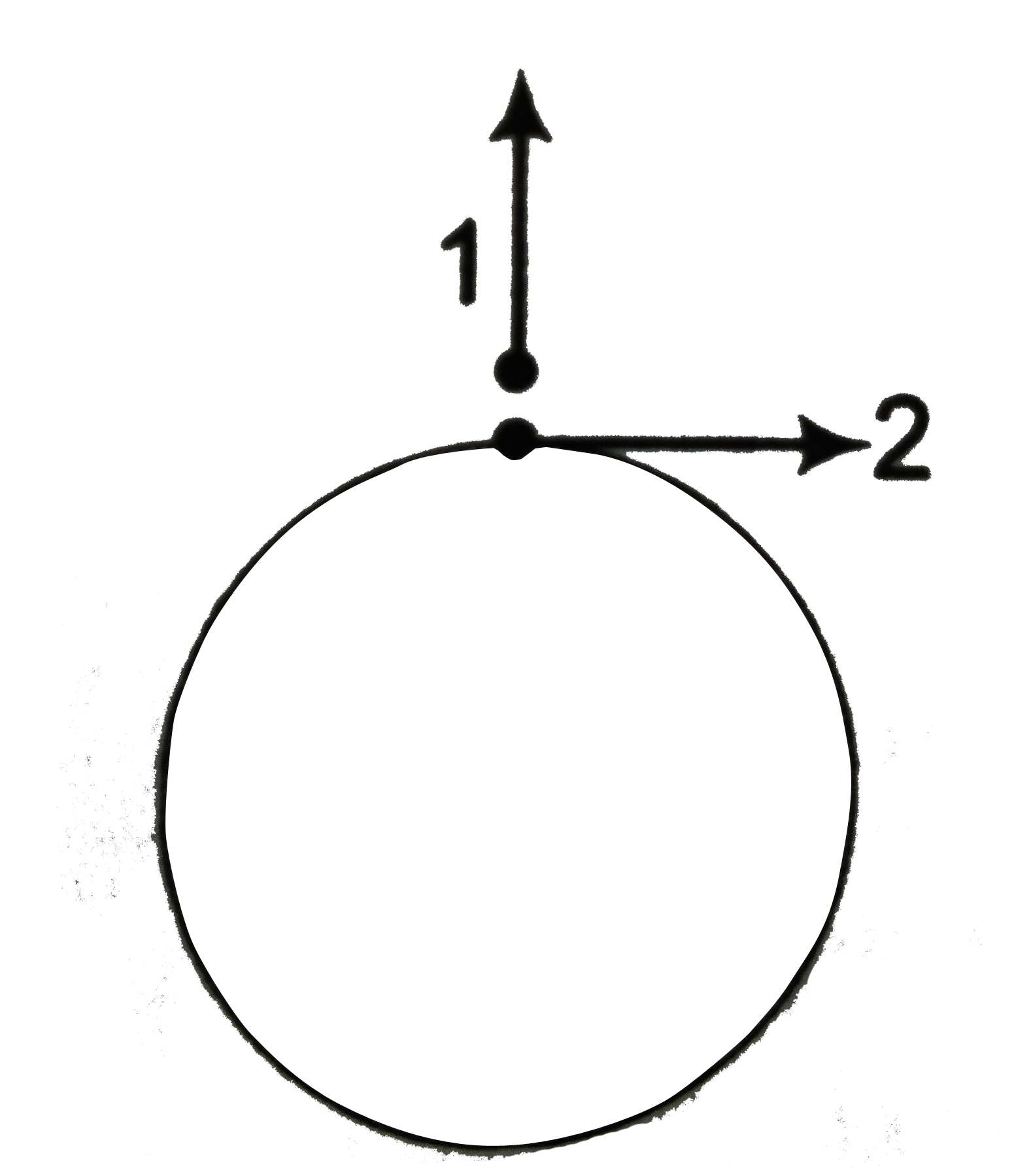A particle of mass 'm' is projected from the surface of earth with velocityυ=2υe, where υe is the value of escape velocity from the surface of earth . Find velocity of the particle on reaching to interstellar space (at infinity) in terms of υe.
The correct Answer is:C
To solve the problem, we will use the principle of conservation of mechanical energy. The particle is projected from the surface of the Earth with a velocity of v=2ve, where ve is the escape velocity from the surface of the Earth. We need to find the velocity of the particle when it reaches interstellar space (at infinity).
1. Understand Escape Velocity:
The escape velocity ve from the surface of the Earth is given by:
ve=√GMR
where G is the gravitational constant, M is the mass of the Earth, and R is the radius of the Earth.
2. Initial Kinetic Energy:
The initial kinetic energy KEi of the particle when it is projected is:
KEi=12m(2ve)2=12m(4v2e)=2mv2e
3. Initial Potential Energy:
The initial potential energy PEi at the surface of the Earth is:
PEi=−GMmR
4. Final Kinetic Energy at Infinity:
At infinity, the potential energy PEf is zero (since gravitational potential energy approaches zero as distance approaches infinity). Let the final velocity at infinity be va. The final kinetic energy KEf is:
KEf=12mv2a
5. Conservation of Mechanical Energy:
According to the conservation of mechanical energy:
KEi+PEi=KEf+PEf
Substituting the values we have:
2mv2e−GMmR=12mv2a+0
6. Simplifying the Equation:
We can factor out m (assuming m≠0):
2v2e−GMR=12v2a
7. Substituting for GMR:
From the escape velocity formula, we know:
GMR=v2e
Therefore, we can substitute this into our equation:
2v2e−v2e=12v2a
This simplifies to:
v2e=12v2a
8. Solving for va:
Rearranging gives us:
v2a=2v2e
Taking the square root:
va=√2ve
9. Final Result:
Therefore, the velocity of the particle when it reaches interstellar space (at infinity) is:
va=√2ve
The escape velocity ve from the surface of the Earth is given by:
ve=√GMR
where G is the gravitational constant, M is the mass of the Earth, and R is the radius of the Earth.
The initial kinetic energy KEi of the particle when it is projected is:
KEi=12m(2ve)2=12m(4v2e)=2mv2e
The initial potential energy PEi at the surface of the Earth is:
PEi=−GMmR
At infinity, the potential energy PEf is zero (since gravitational potential energy approaches zero as distance approaches infinity). Let the final velocity at infinity be va. The final kinetic energy KEf is:
KEf=12mv2a
According to the conservation of mechanical energy:
KEi+PEi=KEf+PEf
Substituting the values we have:
2mv2e−GMmR=12mv2a+0
We can factor out m (assuming m≠0):
2v2e−GMR=12v2a
From the escape velocity formula, we know:
GMR=v2e
Therefore, we can substitute this into our equation:
2v2e−v2e=12v2a
This simplifies to:
v2e=12v2a
Rearranging gives us:
v2a=2v2e
Taking the square root:
va=√2ve
Therefore, the velocity of the particle when it reaches interstellar space (at infinity) is:
va=√2ve
Topper's Solved these Questions
- GRAVITATIONBook:DC PANDEY ENGLISHChapter:GRAVITATIONExercise:Miscellaneous Examples
Explore 8 Videos
- GRAVITATIONBook:DC PANDEY ENGLISHChapter:GRAVITATIONExercise:Exercise 13.1
Explore 5 Videos
- GRAVITATIONBook:DC PANDEY ENGLISHChapter:GRAVITATIONExercise:(C) Chapter Exercises
Explore 45 Videos
- GENERAL PHYSICSBook:DC PANDEY ENGLISHChapter:GENERAL PHYSICSExercise:INTEGER_TYPE
Explore 2 Videos
- KINEMATICSBook:DC PANDEY ENGLISHChapter:KINEMATICSExercise:INTEGER_TYPE
Explore 10 Videos
Similar Questions
The escape velocity of a body from the surface of the earth is equal to
View SolutionA projectile is fired from the surface of earth of radius R with a velocity kυe (where υe is the escape velocity from surface of earth and k<1). Neglecting air resistance, the maximum height of rise from centre of earth is
View Solution
Knowledge Check
The escape velocity from the surface of the earth is (where RE is the radius of the earth )
A√2gREB√gREC2√gRED√3gRE
A particle is thrown with escape velocity ve from the surface of earth. Calculate its velocity at height 3 R :-
View SolutionA ball of mass m is fired vertically upwards from the surface of the earth with velocity nve, where ve is the escape velocity and n<1. Neglecting air resistance, to what height will the ball rise? (Take radius of the earth=R):-
View SolutionIf a body is projected with speed v greater than escape speed ve from the surface of earth, find its speed in intersteller space.
View SolutionA particle of mass m is projected upwards with velocity v=ve2, where ve is the escape velocity then at the maximum height the potential energy of the particle is : (R is radius of earth and M is mass of earth)
View SolutionA hole is drilled from the surface of earth to its centre. A particle is dropped from rest in the surface of earth in terms of its escape velocity on the surface of earth ve is :
View SolutionFind the escape velocity of a body from the surface of the earth. Given radius of earth =6.38×106m.
View SolutionTwo identical particles 1 and 2 are projected from surface of earth with same velocities in the directions shows in figure.

View Solution